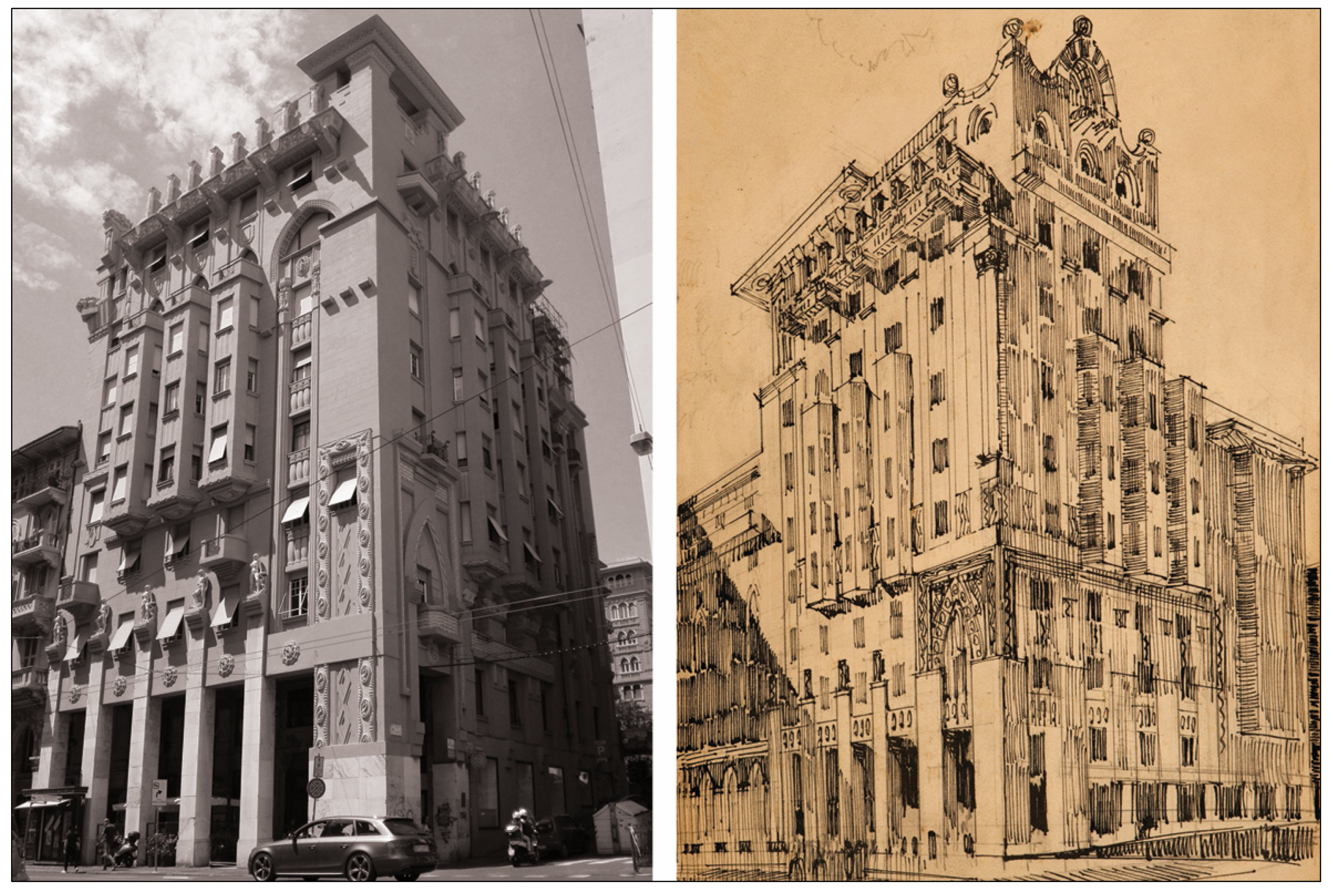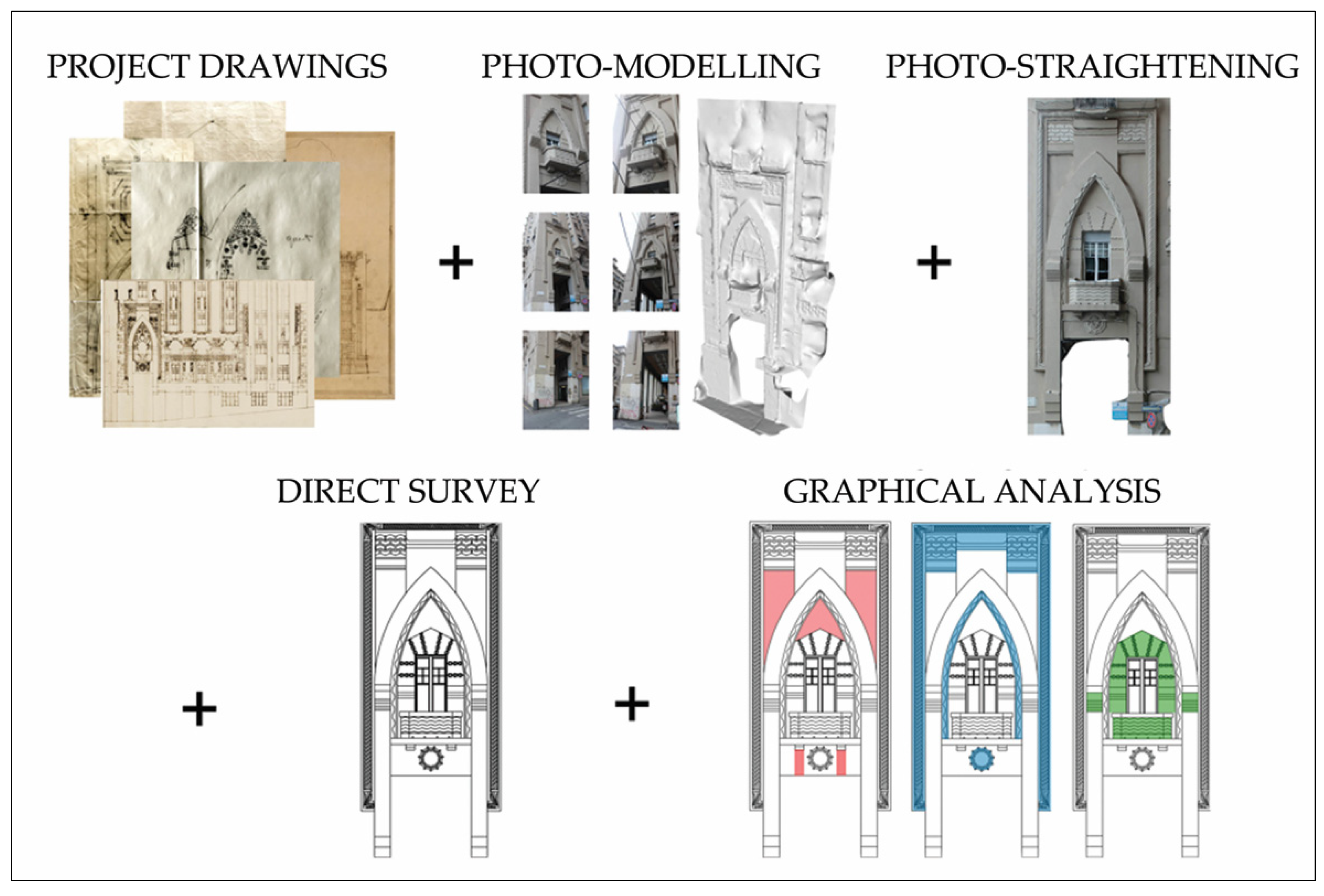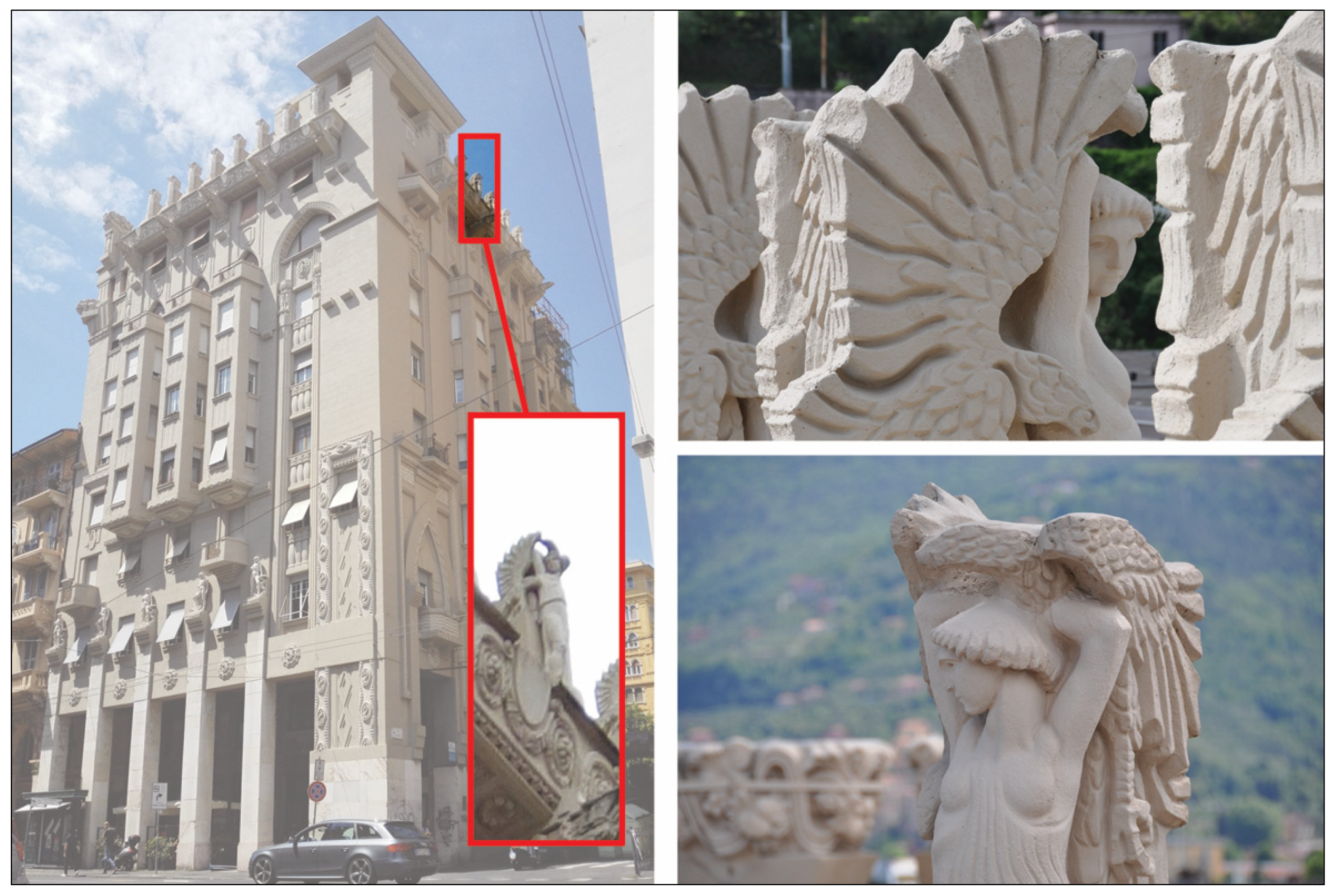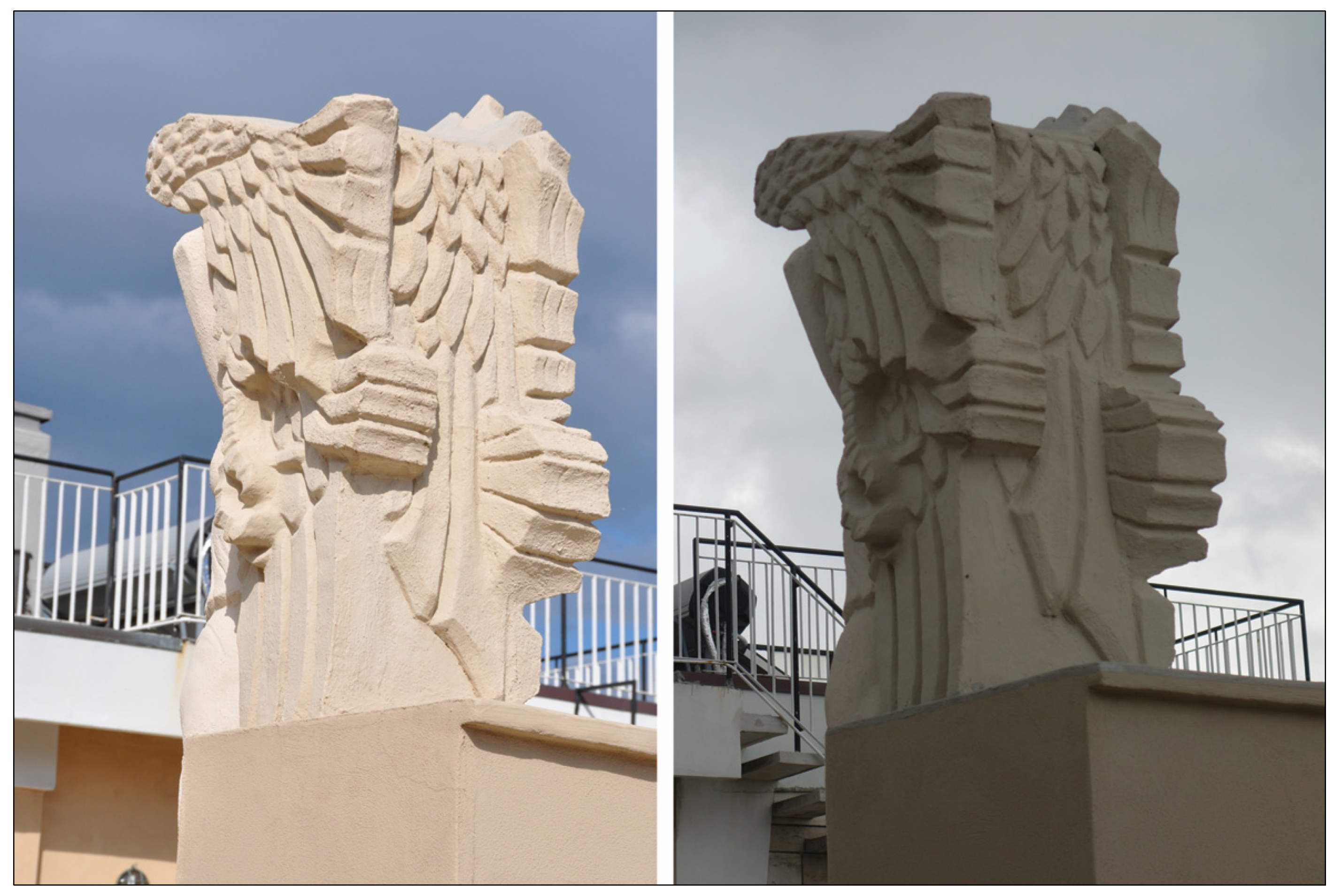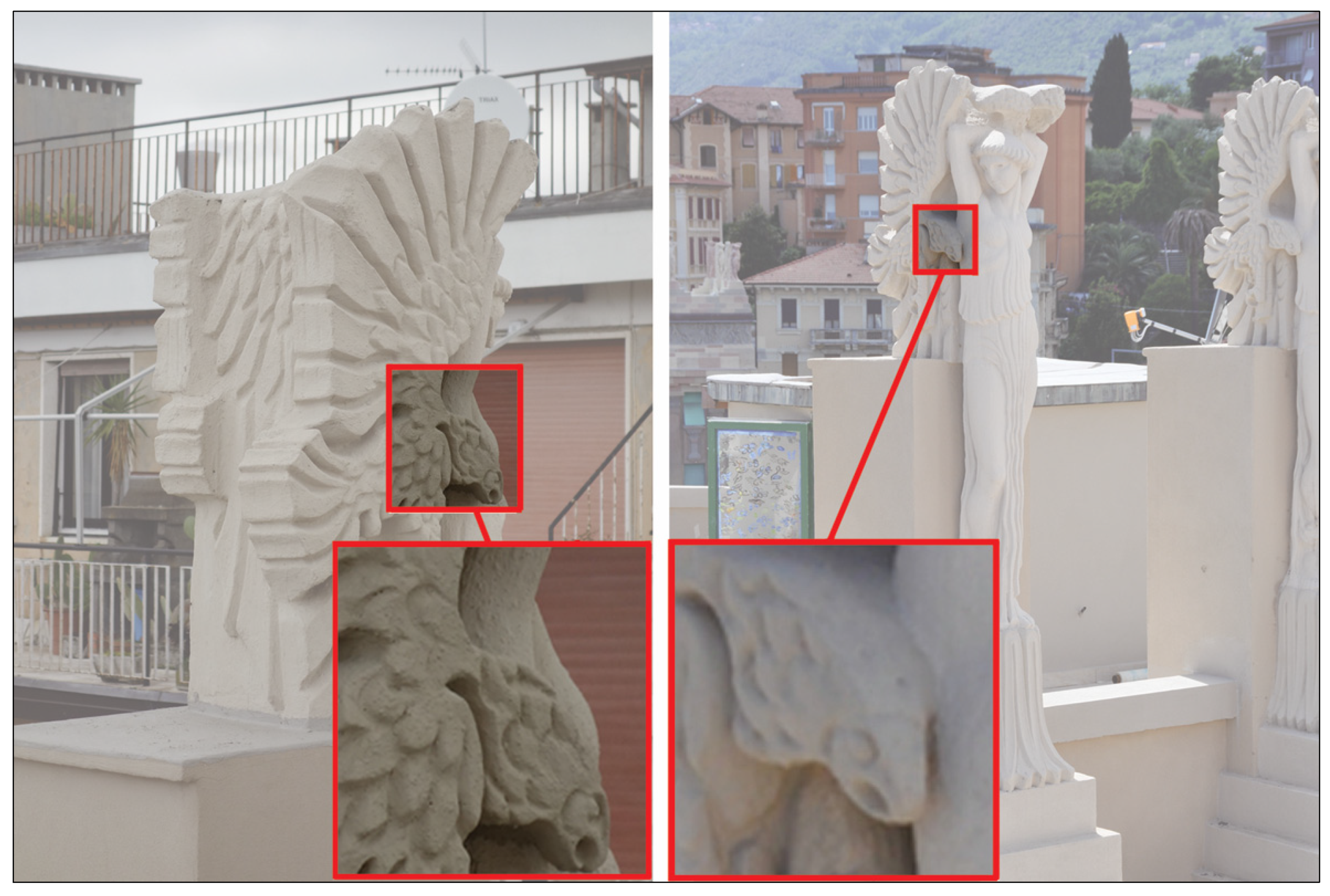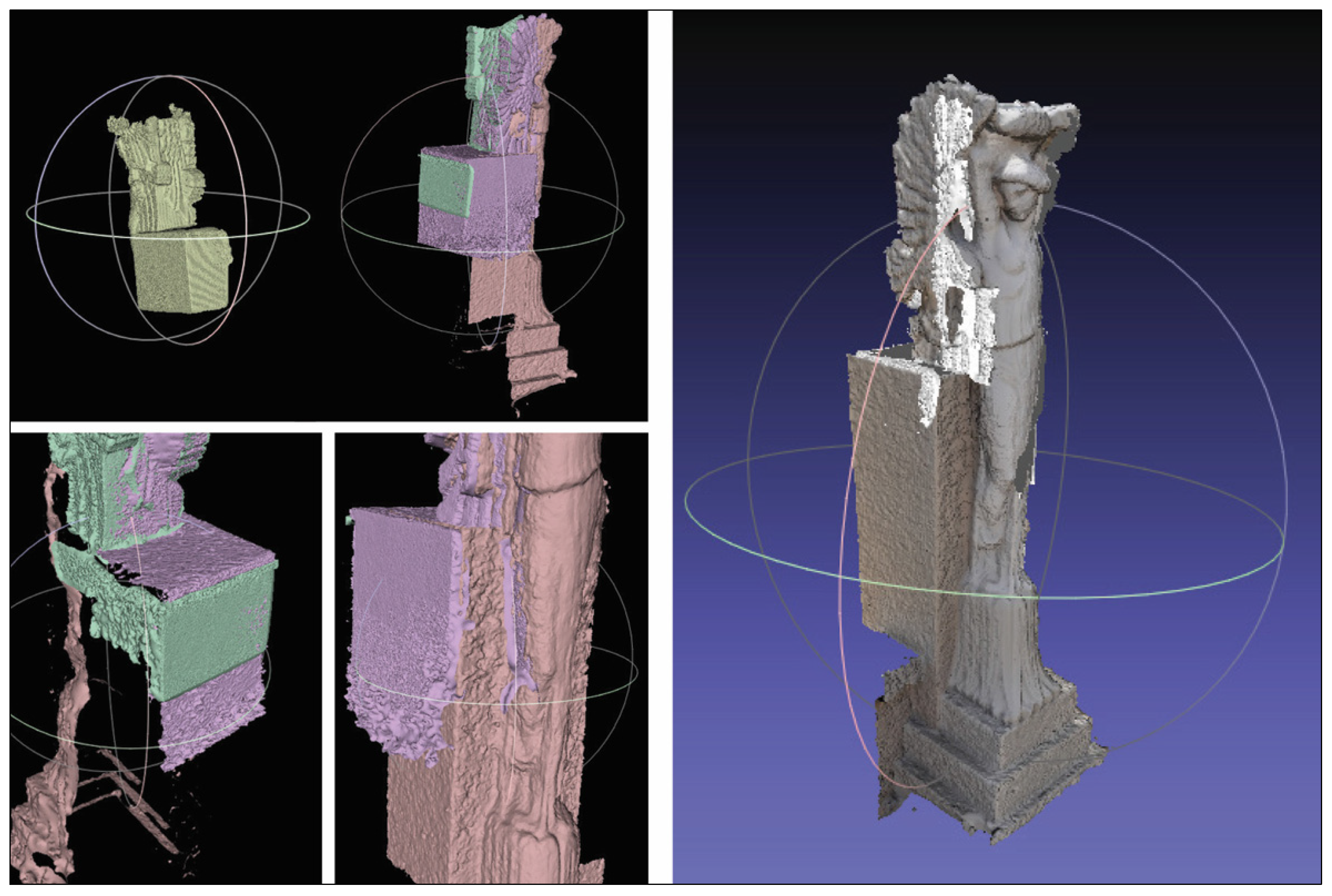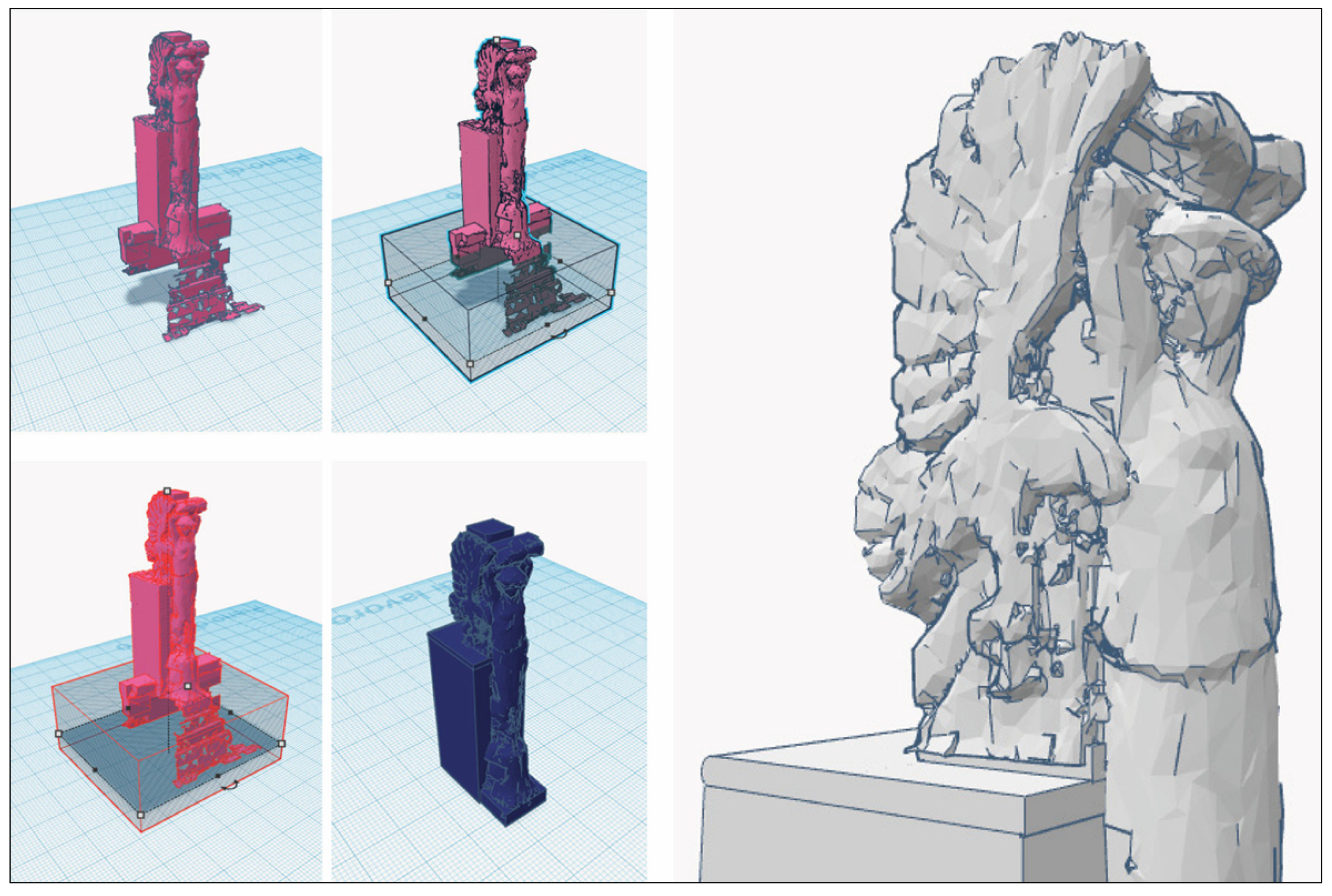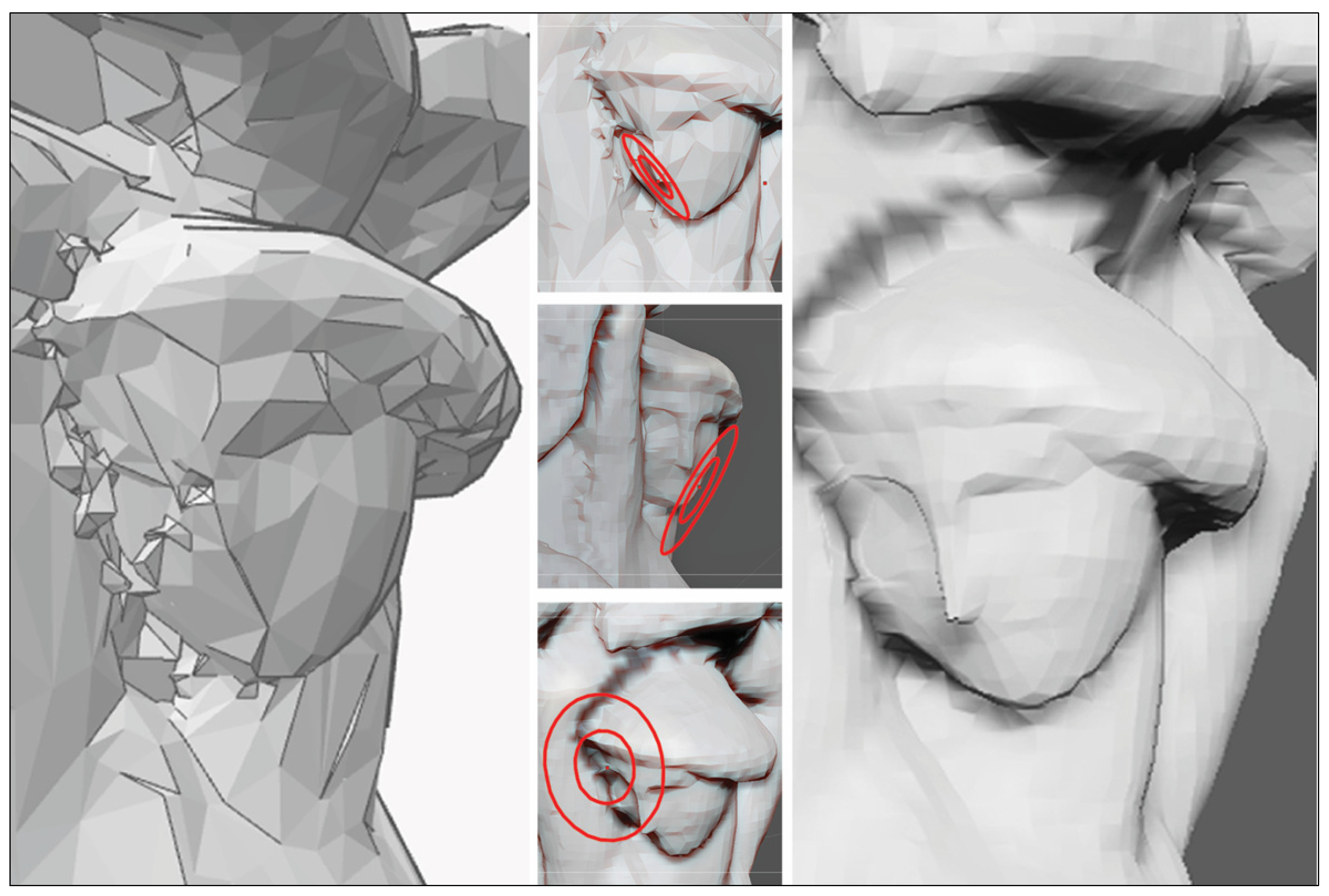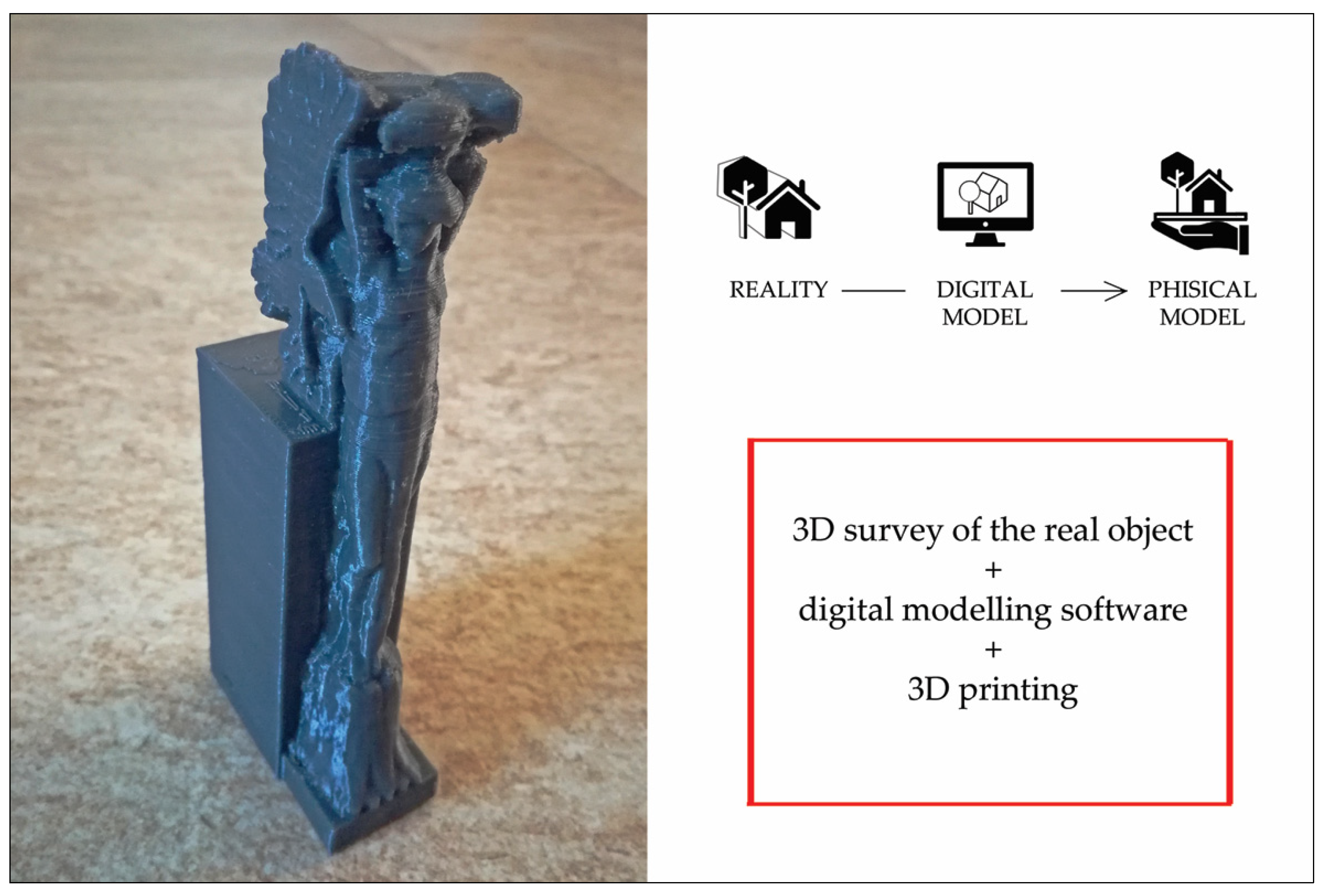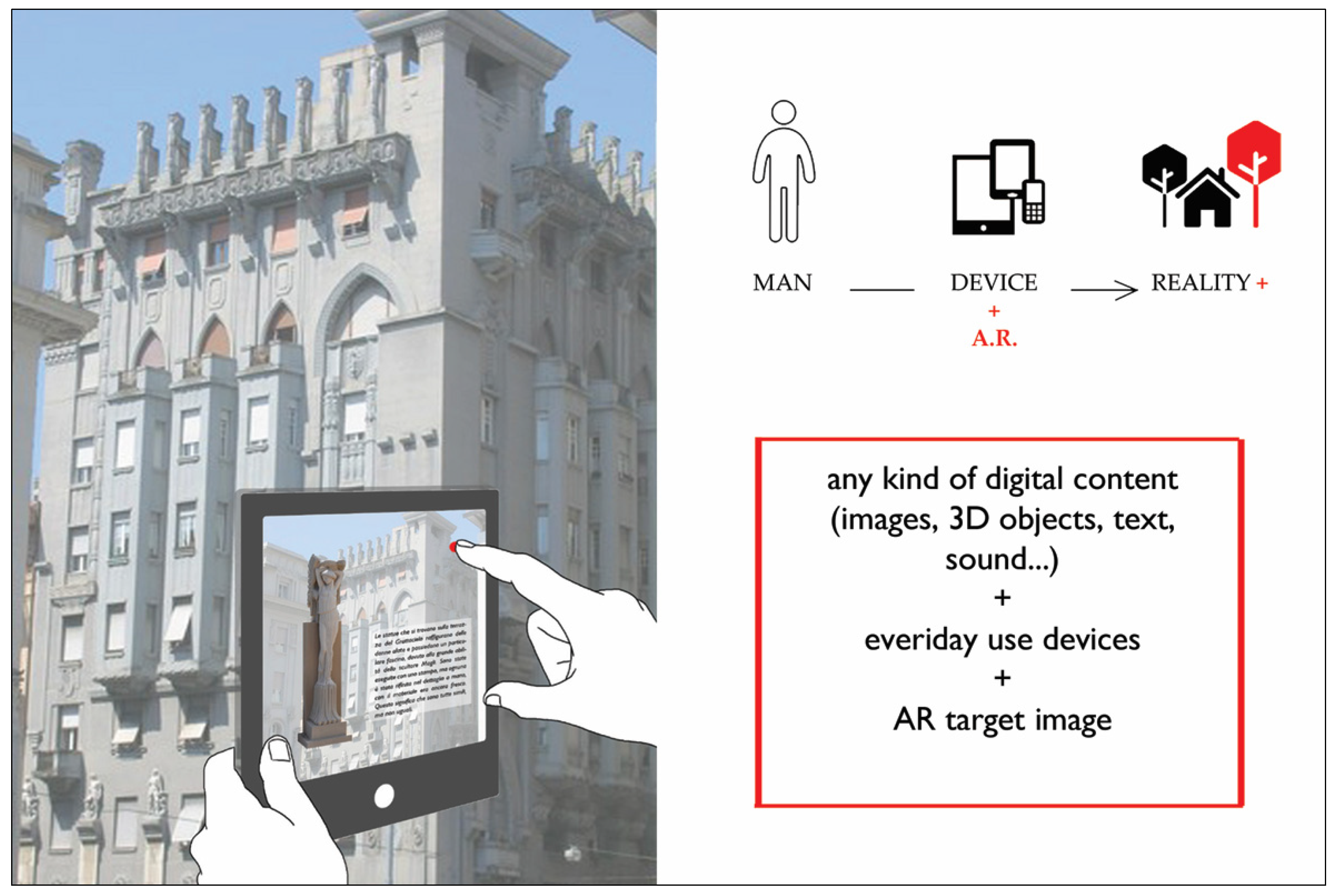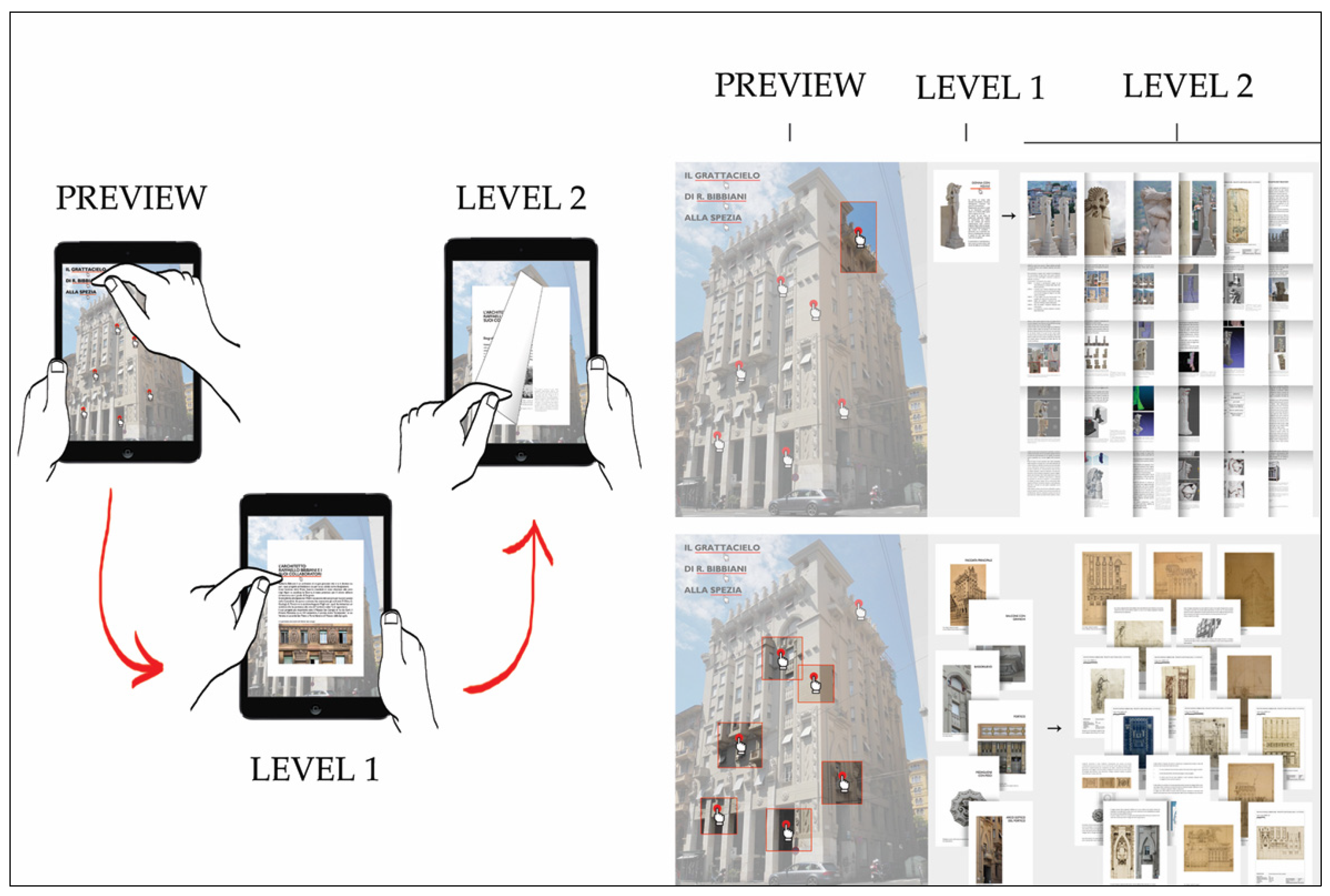1. Introduction
How many times do you visit a city and, seeing a building, you wander about its historical significance? Each palace could have contributed to an important event, an architect who is particularly important for the local cultural scene built it, or still it has a particular artistic value: if this information remains in archives or libraries, hardly a non-specialist researcher will look for them. Therefore, it is necessary to find a way to express the architectural identity in an immediate manner, in order to bring out the cultural aspects in a captivating and engaging manner.
Architectural survey deals with the metric and material definition of these architectures, which does not run out only in taking measures to restructure or store data on “old things” [
1]. It is a complex path of knowledge of the object of study through the direct contact with it and the integration of different sources. Among its aims, there is the transmission of sensitivity, attention, passion and curiosity to existing architecture.
Yet, knowledge is mute without communication. In this, new generations, the so-called “digital natives”, can teach us how to disentangle among the new fluid interactive image-based technologies. The world of architecture and heritage conservation needs to get closer to new communication methods, to increase user engagement through forms of entertainment whose purpose is to game and educate at the same time (“edutainment”). Nowadays, the available resources for a representation that engages the observer cannot exclude the Augmented Reality. This is an avant-garde sector, emerging in the world of the architectural representation, also to the possibility of a mass-use, through electronic devices of everyday use. This is possible thanks to the low cost of design studio and production implementation of the apps, their flexibility in many sectors, their interactivity [
2,
3].
The approach to these new possibilities of representation, emerging, pressing, curious and entertaining, has been aimed at cataloguing them in order to investigate the possibilities of application in a scientific manner to the promotion of CH. The search [
4] starts from the systematic description of different possibilities of digital representation with a proposal for a classification of the types of Augmented Reality. The use of the new technologies in educational games can lead to the growth of the appreciation of the cultural heritage, thanks to new engaging tools that help to immediately emphasize the historical and artistic aspects.
2. The Case Study
These technologies have been applied in the reality of a case study, in which the architectural survey data from traditional and non-contact methods have been elaborated through graphic software and a significant example has been analyzed in depth, up to the realization of a physical model via 3D printing. Three-dimensional (physical or digital) model of a project is still one of the most immediate and concise representation and virtual models have not replaced physical maquettes: indeed, they keep a great expressive capacity. On the other side, the historical and iconographic researches have been implemented in an application that is characterized by levels of analysis of increasing complexity. This app permits the access and the engagement of the users towards the digital contents.
La Spezia had a troubled history since its origins, because of its strategic position on the Mediterranean Sea. In 19th Century it was conquered by Napoleon with the goal of building a huge maritime arsenal, and the subsequent settlement of the yard affected all aspects of urban life causing an exponential growth of the population. Between the two World Wars, it became one of the most important Italian cities and experienced a very thriving period for construction industry: the need to expand and modernize the city center led to the creation of long tree-lined avenues and big palaces, thanks to the contributions of many artists who came to the city to express their creativity in projects that combined architecture and sculpture [
5,
6].
Nevertheless, today the Ligurian city is mostly considered as a city of passage, where tourism is supported by the presence of the nearby summer destination Cinque Terre. The city is few explored as cultural destination, so that architectural heritage is not enough known and valued. As in others small towns, the need is increasing to turn on a concrete interest and to stimulate the curiosity of both hurried tourists and the inhabitants, accustomed to these everyday scenarios.
The twentieth-century building both residences that important civic buildings in Liberty style, mainly occupied the area near the eastern shore of the Gulf. Here, a private residential building known as “Skyscraper” (
Figure 1) aroused particular interest because of the verticality given by its eight floors, unusual for the time of construction, the richness of its decoration and the today difficult access to its fruition. The project dates back to 1927 by the architect Raffaello Bibbiani [
7], one of the biggest personalities in the artistic scene of the time. The same designer named his workpiece “The Sandcastle on the Sea”, because it is located on the extreme edge of the city, facing the sea, and because of the superficial sand-colored plaster and zoomorphic sculptures of marine animals, that seem to emerge from the sand. These sculptures of particular artistic charm are work of Augusto Magli sculptor, carried out in close collaboration with the architect. The particular construction technique involved the use of the new Hennebique French patent, which allowed the construction of a monolithic reinforced concrete frame, accelerating construction times.
The building has been subject of a learning workshop following the interest aroused by the donation to the city from the author’s daughter of almost one thousand sheets of fine project drawings. These have proved to be important from the historical and technical point of view, because, by presenting several design versions of the same work, they allow to retrace the steps of the realization of important buildings, as well as the thought of the artist over time. The undeniable graphic beauty and artistic quality of these drawings is due to the strong vocation of Bibbiani for freehand drawing. They are characterized by Liberty, Neogotic and Déco influences, which alternate in the series of variants, and always maintain a decorative exuberance. A cataloguing of the archive collection, consisting of heterogeneous material, was carried out with the aim of organizing it and the future purpose of enhancing and disseminating it.
The case study, until now little known and studied, has been analyzed starting from few historical information and graphic material of the project, in comparison with and the restitution of direct and non-contact survey, to outline its formal aspects (
Figure 2). Comparing metric results of the survey with archival drawings showed similarities and differences between design and the realization, which led to a greater curiosity about this building, so to carry out further studies for the purpose of cultural enhancement of the building.
3. Statues on the Building Crowning: Issues
In particular, the study focused on the sculpture statues of the Skyscraper crowning, depicting women behind which rise the eagles that surround them with their wings. They were made of concrete with a formwork, but each one was finished in detail by hand. They radiate a particular charm and represent the most distinctive decorations of the building. However, they are positioned very high in private property, foreshortened, and overlooking the void: it is not possible to appreciate them from the public road level (
Figure 3). Even being guests of the owner of the terrace or the tenants of the opposite palace, the visibility remains partial of the face or back of the sculptures.
For educational and gaming applications, a virtual 3D model of one of these statues have been implemented based on photogrammetry and laser scanner survey, not without difficulty.
The result of photo-modelling with simple tools and didactic purposes [
8,
9] led to difficulties in the frame acquisition phase, compared to having a set specially arranged with backgrounds and adjustable lighting (such as a statue in a museum) and/or advanced instrumentation (platforms, drones). It is obvious that the major problem is related to the reduced accessibility, due to the location of the sculptures that, overlooking the void, make a classic 360-degree photographic campaign impossible [
10]. This led to the need for two separate photo sets: the back and sides photographs were taken from the skyscraper’s terrace, while the front part was framed by the adjacent building.
For organizational needs, the sets were made in different times causing discrepancies between the two. This made the union very difficult because of the variable background open on the landscape, the difference of photographic lens and focal length due to the different distance of shooting that caused a loss of resolution and sharpness, the different atmospheric light and of colour. When you are outdoors, you have to rely on natural light and the variations due to the flow of clouds and the passing of the hours. If there is full sunlight, the photos quality is better and the details are sharper, but the contrasts are too strong as the software recognizes the light and shadow parts in the model as lighter or darker colours, distorting the true hue of the object. On the contrary, with cloudy sky, the colours appear uniform, but this homogeneity causes difficulties for the software in recognition of the depth and definition of details (
Figure 4).
This resulted in management difficulties in the modelling software tested (Agistoft Photoscan, Autodesk Remake, Visual SfM), especially at the time of alignment between the two frame groups, where it was not possible to identify the same points on both the front and back, due to the lack of recognition of the union points on the different photographs (
Figure 5). Even inserting a number of markers to force the union of the two parts, the model presented several gaps, as the photo set was not sufficient to cover all the parts of the statue properly because of the position of the statues, which limited the capture of shots in some points. The major defects are especially noticeable on the sides and on the base, i.e., the most difficult parts to frame from different angles due to the lack of space.
Therefore, separate modelling of the two outer and inner faces was carried out, but also in this case the deformations near the edges of the two “shells”, caused by insufficient photographic information, made it impossible their alignment with the 3D modelling software (ex Rhinoceros) (
Figure 6).
These difficulties confirmed that, although sometimes the emphasis is posed on the ease of use of photo-modelling by non-technical specialists, the photogrammetric project does not just mean “taking pictures”. Much attention must be paid in the evaluation of accessibility, light, resolution and position of shooting, intended both as distance between shots and as distance from the target. Photogrammetry can lead to optimum results, if done correctly through a conscious and accurate project.
The complications were such as to require putting aside the photogrammetric model in favour of an experiment on laser scanning. This, even if it was only planned to have a reference metric base of the entire building to support direct and photogrammetric surveys, and therefore, in the crowning area it showed a lower density of points. Considering the level of detail needed to 3D print a dozen centimetres high physical model, it was concluded that the cloud of points had a sufficient resolution and minimal gaps (missing surface areas).
4. Goals and Proposals for Communication
After the first phase of research and survey, and after comparing the archive material with the output, this was brought into practice, so to build an effective interaction and communication of both physical and digital content.
Physical models, thanks to their materiality, allow digital projects to actually acquire the third dimension and to expand the formal, visual and tactile experience of the observer, thanks to their great expressiveness and “touchability” [
11]. As modern design uses increasingly advanced technological methods, so you need to establish a relationship between the digital work and its physical playback. Building a scale reproduction allow people to enjoy these sculptures, and 3D printing is a possible way, in the materialization of three-dimensional objects using additive extrusion of material filaments. It start from a digital model, with the aim to reproduce the objects in the form of visible material for its better understanding, above all in case of complex geometry and anthropomorphic or zoomorphic shapes.
Another instrument of great expressive capacity and mass involvement identified among the new technologies is the visual communication of the digital object, in which the cultural content can be described in various levels of detail, to involve the user and to stimulate the interaction with it. The study focused on the analysis of potentialities of both virtual and Augmented Reality, choosing latter because of its capability of superimposing digital content (3D objects, texts, audio and video images) to the “natural” vision of the real scene in which one is immersed, in order to “heighten” or “boost” the vision of the environment and without isolating the observer from the real life [
12]. It’s easy to confuse it with the editing and post-production techniques or with the concept of Virtual Reality, but the difference between V.R. and A.R. is intuitive. In the first case, you are watching a projection of a screen of a simulated world, entirely made up of virtual objects; in the second case, an integration between realistic images and interactive virtual objects is shown. In fact, A.R. is based on the enhancement of the senses, while the virtual reality on their alteration.
Augmented Reality has an infinite range of possible applications, the most known and most dated ones, relating to the first experiments, are in military and medical field [
13]. Today, research span in other areas and it is the ideal tool to gain visibility, mainly in the field of marketing and advertising, given the huge visual impact that it is able to produce. The massive use of the web also boosted the development of platforms that allow A.R. applications to be enjoyed via Internet through smartphones and tablets, so it is always easier to get all kinds of information in real time.
Already widespread for gaming and advertising, this new digital technology is now entrusted with the task of communication architecture and its events. These new technologies led to a gradual process of transformation in the cultural sector, offering to Cultural Heritage innovative possibility of management and organization structures and activities, and the promotion of new forms of communication and interaction with users.
For example, Rome Reborn is an international historical disclosure initiative whose goal is to create 3D digital models that illustrate the urban development of ancient Rome. TripEmotions is a game entirely set within historic buildings digitally reconstructed, such as the Benedictine Monastery in Catania, combining playful and educational pathway. Back to Pompei [
14] is also a project of digital reconstruction of the archaeological site in Campania, realized in parallel with a project dedicated to the Baths of Caracalla. Another example is the digital reconstruction of the historic apartments of Villa Reale in Monza [
15], which can be observed through a viewer during the exhibition path inside the rooms. A.R. can also be used in explaining built or never built architecture, to conjecture a 3D model from 2D original drawings [
16,
17,
18], to give life to paintings as the project dUcale in Urbino [
19,
20], to design by overlapping digital content to physical models [
21].
To experience this potentialities on the case study, a tablet application was implemented that can show in-site the results of the scientific search, real-time interacting with the observer. In this case, the digital content emerges to express the unique characteristics of the building at the historical and graphical level.
5. 3D Modelling and 3D Printing
As application of this experimentation, it was chosen the statue of the Skyscraper already subject to the study of the photo modelling exercise, to make available what is now hidden due to difficulties of physical and visual access.
The point cloud had been “worked”, to obtain a model that could be compatible with the 3D printer (
Figure 7). First, the various scans were converted in .ptx file format and imported into Recap360Pro software. The first cleaning was done, selecting only the portion of survey containing the statue. Then, the points was exported and step by step converted into .obj format able to be worked in MeshLab. This software allow to build surfaces and to close the remaining gaps, with the reconstruction of Poisson surfaces. Then, the product was exported in .stl format compatible with the 3D printer.
However, the resulting file was not yet optimized for printing: it required a series of precautions and elaborations, to make the final product tidy and clear, because the necessary transition between various 3D modelling software compromised the quality of the surfaces. The .stl file was imported into TinkerCad, a program that allows using simple solid geometry to set the scale of representation of the statue and to fix the flat base of the model. All the merged elements converged in another .stl file, which only needs the latest finish, thanks to an organic modelling software, ZBrush. This, unlike other modelling programs, sees the imported object as if they were made by clay and whose shapes can be stretched, squashed, deformed, just as if the mouse cursor was a finger crushing the plastic material. Depending on the size and intensity of the brush used, it is possible to obtain many different effects, and it is important to evaluate the results as they greatly affect the outcome: a very small brush will work on the individual vertices of the polygons selected; otherwise it will reconsider much more surface (
Figure 8).
It is necessary to point out that this type of finishing has been conscientiously chosen with the aim of obtaining a clear and easily interpretable product, by smoothing or enhancing the features that now appear more similar to a real sculpture, although the survey accuracy is decreased due to the stretching and flattening of forms. In this case, the metric accuracy of points has been sacrificed in favour of a more aesthetically attractive final representation. Once a satisfactory result was achieved, the final .stl file was exported back to the 3D printer software and with more few steps, the machine faithfully worked the file in a very short time and the physical model was ready.
All the difficulty is in in the management and preparation of the file. At this point, the question arises: what does the 3D printing add to a drawing, 3D model or a photograph? Is this great work worthwhile? In this case, given the complexity of access, a product like this effectively manages to make the object approachable (
Figure 9).
A large number of different materials is available to print the shape of the model, according to the purpose for which it was conceived. In this case, it was chosen a colourful plastic material, reflecting on the communicative purposes from a psychological point of view: the coloured plastic is commonly associated to a toy and this leads to an instinctive palpability of the statuette. The result would be different in the case of clay or chalk 3D printing, as light and smooth materials are associated with a sense of quality and delicacy, leading to an unconditional fear of dirtying or breaking them. A limit of 3D printing is the impossibility of printing textures, but through the work of an artisan, it is possible to integrate the missing colour features through hand finishing and painting.
6. Augmented Reality and Edutainment for Cultural Heritage
To allow the contents of the search to be accessible, an application has been tested. The aim is to include all information relating to the case study of Bibbiani Skyscraper who is dispersed among archives, libraries, oral sources and analytical material, and merge them into a single digital archive, directly consultable on site. The principles of Augmented Reality make the consultation interesting and interactive and intrigue different types of users (
Figure 10).
Unity is the software used to implement the application, a development environment frequently used for video games. It includes a three-dimensional modeller that manages the game scene (or application, or any type of 3D content), just like any parametric modelling software. It uses a C# or Java programming language, with a “for component” approach. All the component of the scene (a 3D model, a light, an element of a graphic interface, a sound, etc.) are linked to different functionalities by scripts, i.e., codes that say what to do to the element to which they are associated.
The modelling tools are very simplified, but you can import in the virtual space objects from other software. In the test, the data sheets relating to the building and the model of the statue have been uploaded. The scene is settled as desired, by moving the objects and the camera through which the information will be displayed. The scripts are associated with each element: for example, the model of the statue slowly rotates around its vertical axis.
From a practical point of view, when the Skyscraper image is framed via the camera of a tablet or smartphone, the application recognizes the shape of the building and starts presenting the digital content. The first screen shows a text that identifies the image of the building as a target and highlights some significant elements through keywords and coloured symbols that can be alternatively selected to display information inside the screen.
The first level of depth is settled as “touristic curiosity”, showing a summary of the most important information on the building. The title of the sheet is itself a link towards a more in-depth study for a higher-level knowledge (
Figure 11). Hotkeys are the name of the building (all the details about the palace’s story and description), the name of architect (stages of his formation, his works and collaboration with the workers, in particular with sculptor Augusto Magli), the name of city (the vicissitudes of the conformation of La Spezia and the cultural and political context at the beginning of the Twentieth Century). Other targets mark some elements of interest on the facade and activate the visualization of archive drawings, and the data from survey and photo-modelling and the results of the search.
The ultimate goal would be using the entire facade of the building as a target for the application, in order to enjoy the app directly on site in real time. The technology is not yet ready for this, because, as before seen for single photographs, there are too many unpredictable variables: different cameras, focus, perspective, distance, weather, light and framing. At now, it is difficult that the software can recognise a building under all this conditions, in the same way it can do with a human face (facial recognition technology).
7. Conclusions
The need to preserve the historical and artistic memory of the heritage is deeply felt: these new technologies can spark interest and stimulate the curiosity of the public in the artistic heritage, as well as to trigger spontaneous care and safeguard actions, knowledge and valorisation, as more and more interesting and effective projects. The aim of this specific work in this field was to investigate some of the new architectural representation techniques, in order to highlight the special characteristics of the case study, represented by Raffaello Bibbiani Skyscraper in the city of La Spezia.
The direct approach to the palace is proved a necessary basis for the accomplishment of this work. The importance of direct and non-contact survey, with its advantages and disadvantages, emerged as a necessary act to understand the building. The extensive historical and archive research allowed to deepen the knowledge of the building, to show its metric, technical, formal and graphic characteristics, to make possible to reconstruct its building phases and to understand the relationship it has with the city and its inhabitants. Recognizing the historic-artistic value of the building, promptly led to an attempt to enhance it by divulging the information acquired.
The new techniques of representation are applied to explore the physical models realized via 3D printing and to create an Augmented Reality App. They both process and apply the digital data from survey. The path to the processing and the realization of these products faced several difficulties, first of all the limited accessibility of the building. This factor influenced both production time and results, but a satisfactory level was reached indeed. In particular, the results gained can reach different levels of detail and stimulate curiosity towards architectural heritage, even by a distracted audience or without the skills necessary to read the traditional architecture representation methods.
This experimentation offer talking points about the new technologies and the impact they have on the way the architectural contents are seen. Whether this will be the future of architectural representation, it is to be evaluated over time, when these technologies will be spread more widely in the industry. Society is changing the way of thinking and interacting with the external world, and this is increasingly favoured by the use of technological devices. With such a significant change in the collective mentality, it is necessary to extrapolate the positive notes and direct them towards a codification of this new architectural representation in favour of the enhancement of the artistic heritage, to spread an engaging cultural message on a large scale.
In the future, the research could be implemented with more information and data, extended to other Bibiani’s works or to other buildings in the city, until the creation of an accessible digital cultural net. The hope is that this experimentation will not remain an isolated case but it will invite citizens, tourists and academics to participate and know this remarkable artistic and architectural heritage.
